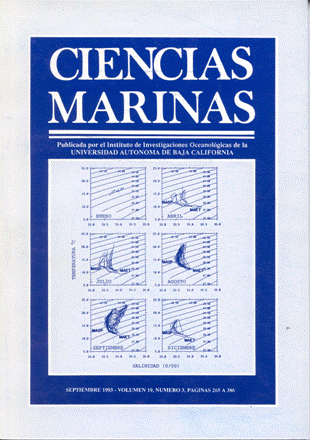Feeding behavior and dietary composition of the northern anchovy, Engraulis mordax Girard (Pisces: Engraulidae), off Baja California, Mexico
Main Article Content
Abstract
Feeding behavior and dietary composition of northern anchovy, Engraulis mordax, off the west coast of Baja California are analyzed. The visual field for prey detection is 104 mm and the basal area of the vision cone is 125 cm2. The mean number of gill rakers in the first lower branchial arch is 41; gill raker gap increases as fish grows. Diatoms, anchovy eggs, crustaceans, dinoflagellates and protozoans are the major by-number contributors to the diet of E. mordax. Filtering mechanism acts over a 0.05 to 1.50 mm range of prey length, while selective particulate feeding occurs from 1.51 to 5.00 mm prey size spectrum. The morphometric relationship between intestine length and fish length is expressed by potential functions, and the number of curvatures varies as fish grows. Although phytoplankton is the principal by-number component of the stomach contents, zooplankton prey are consistently the major source of carbon in the diet. Prey size increases as predator grows.
Downloads
Article Details
This is an open access article distributed under a Creative Commons Attribution 4.0 License, which allows you to share and adapt the work, as long as you give appropriate credit to the original author(s) and the source, provide a link to the Creative Commons license, and indicate if changes were made. Figures, tables and other elements in the article are included in the article’s CC BY 4.0 license, unless otherwise indicated. The journal title is protected by copyrights and not subject to this license. Full license deed can be viewed here.

